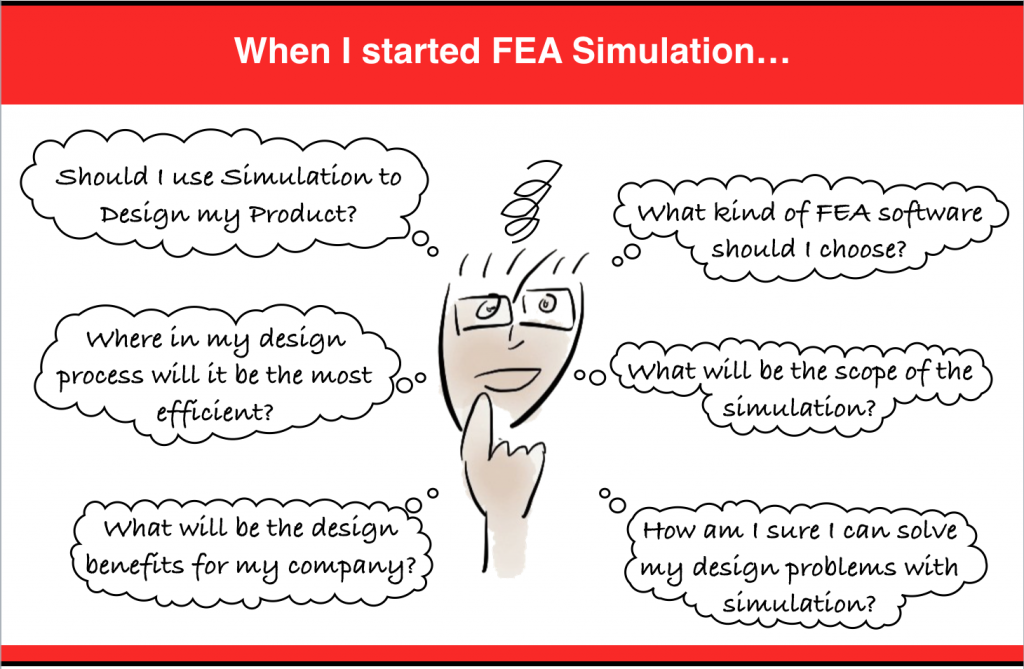When I started FEA for the first time, I did everything wrong…
I started with tutorials, without really understanding either the real benefits of simulation for my company or the capabilities and limitations and I didn’t know how to define the scope of my analysis.
Did my ignorance undermine my performance and the real impact I could have had on the design process in my company?
Yes… I spent months doing useless models that weren’t fit for simulation, trying to get results impossible to obtain and alienating my manager about the software…
The real problem?
I didn’t know it…(and that wasn’t really the software’s fault…)
OMG, that was a big revelation, I hope I knew what I know now MUCH EARLIER.
Why don’t most engineers start by learning those earlier?
I am still wondering… maybe because that’s not as sexy as getting colorful results… so we tend to focus on that at first.
Also, there is so much disinformation about FEA Simulation out there that it is difficult to see clearly when you start…
In fact, there are 2 types of people who start FEA:
– Those who think FEA is just a tool to check design (managers)
– Those who think FEA can do everything (design engineers)
Both are partially wrong, and it’s important to understand why because an FEA Software is much more than a « design checker », it can actually benefit your company in several ways, but it is not « all powerful » either
Understanding the role of FEA will help you to bring more benefits to your company by mitigating the risks of doing projects that have obvious flaws you can’t see with bare eyes, but it is also a tool that can have much more impact on your design process and actually motivate your designers to search for more creative ideas.
If you think FEA is all powerful… be my guest!
I would love to think that as well…but that’s just not plain true.
So…what is the basic knowledge I need to have to start FEA simulation?
First, you have to understand the real role of simulation & the business benefits for your company.
Why do I need to understand the business benefits?
There are 2 main reasons you need to know the business benefits:
If you are an engineer-manager (or plan to become one) and you want your company to invest into an FEA Software, then you have to know exactly what will be the benefits for your company and how you will be able to integrate the software into the design process in the most effective way.
If you are a design engineer, this knowledge could be also extremely useful to you when you will have to justify the usage of a software to work and improve your design. Firstly, knowing the real benefits for the company will give you a powerful leverage to get your company to invest into the right tools for your project and secondly, you will be able to make other people working with you understand more clearly what you do and the value you provide to them with simulation.
Once you understood the business benefits, you have to understand the capabilities and limitations of the tool.
Why do I need to understand the capabilities and limitations?
Saying you can do « everything » is just an easy way out that prevents you to really get down to earth and start to consider the real realistic options.
Maybe you already know that, but most of the time, too many choices and too many possibilities just hinder your execution as much as not having the basic knowledge about the tool.
In fact, you could be extra proficient with the tool, but still not know how to simulate your model because you have a too extended array of choice.
Should I be doing a nonlinear analysis? should I consider the dynamic component of my problem? Can I actually simulate such a complex assembly? What are the assumptions the software is doing in X and Y cases?
Those are questions that have the power to slow you down for days or sometimes even weeks…
I don’t blame you… in fact, it was the same for me!
It’s easy to get lost when you are not crystal clear about the capabilities and the limitations of the tool and when you didn’t define the scope of your analysis!
Now there’s another VERY IMPORTANT reason why you should also know the role of FEA in details… that’s if you plan to invest in an FEA software solution (or upgrade your existing one)
Why do you need to know about the types of FEA software?
When you will start to contact companies selling FEA software because you are interested in investing in one of their solutions, those companies will obviously try to sell you more features and modules than what you actually need…
Some companies have PhD guys waiting for your call to tell you that you need to buy the full package because otherwise, you won’t be able to analyze Y or Z…
What do you do in this case?
You start to learn about the software options and search by yourself…but most of the time, that’s already too late, and those PhDs can be sometimes VERY persuasive.
(I am not even mentioning the fact that some companies design software packages in a way which is purposely confusing to the non-initiated user…)
That’s why knowing in advance what kind of FEA software is out there and what you should be choosing from at the beginning is crucial
Now, let’s suppose that you have an FEA Software already and you have few designers who are assigned the task to use it to do projects and improve their designs (You may even be one of those designers)
How do you start your first simulation project and how are you sure you will be able to complete it successfully?
If you do not have much experience with such FEA software, it can be overwhelming at first to think about all the technical details you need to get right to do simulation…
But that’s probably because you didn’t do the first most important and necessary step that most people simply don’t do… defining the scope of your analysis.
Defining the scope of your problem will make everything about your simulation much easier afterward
For some easy projects, this step is even so powerful that the only thing you will have to do after is executing without doubt the strategy that will always give you the results you need.
If you have only one of the problems described here, or if you prepare to meet some of them in the near future, then this short course will be exactly what you need.
Who am I by the way?

My name is Cyprien Rusu, I am a CAE engineer who wants to teach the right bases of FEA Simulation to designers, engineers and everyone aspiring to get it right!
Hundreds of FEA students followed my free FEA webinars on Youtube, read my blog articles on feaforall.com and joined my FEA courses to learn more and improve their understanding of FEA and become better engineers!
The FEA courses I create are the most easy to understand material available on internet!
Introducing “FEA Design System 1: The role of Simulation”

Here’s what you will learn in this course:
- When simulation is needed and the most beneficial in the design process (lesson 1)
- The 3 stages of integration of simulation in the design process (lesson 1)
- How early simulation helps the business of your company (lesson 2)
- The 5 business benefits that can be obtained by integrating simulation (lesson 2)
- How benefits of simulation are linked to each stage of the design process (lesson 2)
- What is the problem-solving environment and its impact on your FEA simulation (lesson 3)
- Some important knowledge about FEA output data (lesson 3)
- Where the imprecision of FEA comes from (lesson 3)
- The errors and risks in FEA that can influence your results (lesson 3)
- The difference between the 3 types of FEA Software on the market (lesson 4)
- 3 important factors to consider when choosing an FEA software (lesson 4)
- 5 important steps that will help you to define the scope of your FEA problem (lesson 5)
- Why defining a goal for your simulation is important (lesson 5)
- How to get the right answers and how to be sure about what they actually mean (lesson 5)
What is provided inside this course?
This course is a complete « at your own pace » online video course composed of more than 2 hours of video and other material. Once you joined the course, it becomes available to you forever. Just log into the course system and access to the videos, PDFs, and articles that you would like to read.
The Course is structured of the 5 following lessons:
1- The benefits of FEA in product design
2- The business benefits of FEA
3- Capabilities and limitations of FEA
4- FEA Software for Product Design
5- Defining the scope of your analysis
Sure… that’s a small investment of time (2 hours max) and a very small investment of money (in comparison to the benefits of the knowledge you will enjoy from it), but that’s definitely worth it thousand times!
What people say about me and my courses:
How can I join the course?
- Purchase the course by clicking on the Purchase button below
- You will be redirected to the paypal website where you have to enter either your paypal credentials or directly your credit card information if you do not have a paypal account
- After completing the purchase on paypal, you will receive an email with your student login and password
- Using these credentials, you can log into your courses section where you have a lifetime access to your course “FEA Design System 1: The Role of Simulation”
What if I join and I don’t like the course?
I have a zero-risk policy. If you don’t learn anything important in this course, or even if you simply decide it was not worth the investment, I’ll give you a 100% money-back guarantee up to 30 days after you purchased the course.

(In fact, you could even take the course, learn from it and then ask for a money-back and you would have it for free… but that wouldn’t be fair for me, so I hope that you won’t do that ;-) )

